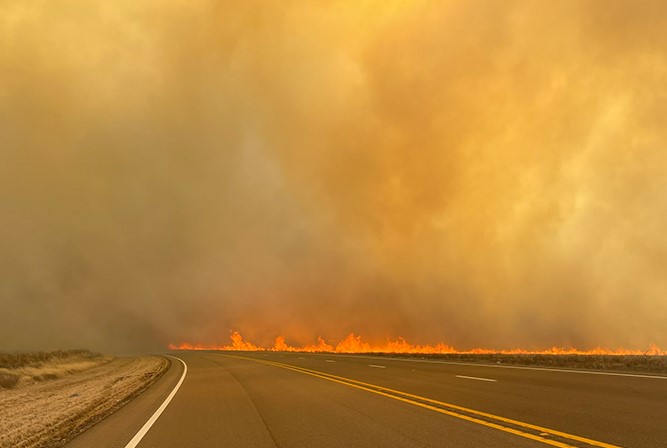Quail Response to Large-Scale Wildfires in the Texas Panhandle
Summarized by Dale Rollins

Quail hunters north of Interstate 40 in the Texas Panhandle enjoyed a good quail season this year. Most of that region had received above average rainfall over the past year, and range conditions were good to excellent. Unfortunately, excellent range conditions in this area also equate to an increased risk of wildfires when red-flag conditions reign, as they did the past 2 days.
Accordingly, several large wildfires raged across portions of the Texas Panhandle on 27 February 2024. Smokehouse Creek Fire had scorched over 850,000 acres as of Thursday morning. Reports of damage have included loss of houses, livestock, and related infrastructure (e.g., fencing). So, how did the area’s wildlife fare?
This report summarizes what we know about the response of bobwhite quail to similar fires in that region that occurred in March 2006.
My colleagues and I with Texas A&M Agrilife Extension Service monitored bobwhite response for 3 years following the “Borger” and “I-40” fires that each burned roughly 350,000 acres in March 2006. In other words, fires that were similar in scope and weather conditions to the fires that burned yesterday. Our goal was to determine how long it took for bobwhites to “recolonize” large areas with very little residual cover, i.e., “moonscapes.” We conducted whistle counts in areas that were either “inside” or “outside” the wildfire-impacted areas. Transects typically extended 5 miles into the interior of the burn and also 5 miles outside the burn. Counts were conducted from 2006-2008 on 6 sites; 3 included in the Borger fire and 3 in the I-40 fire.
In summary, bobwhites on sites characterized by sandy soils bounced back after 2 years following the burn, whereas quail abundance on “tighter” soils (e.g., clay loams) showed a much slower recovery. It is noteworthy that sandy soils (characterized by shinnery oak, skunkbush sumac, and midgrasses) likely had higher quail abundance pre-burn than clay-loam sites (characterized by broom snakeweed and shorter grasses). Bobwhite abundance, and desirable cover on the sandier sites typically recovered by 2 years post-burn.
Precipitation in the area was above average from 2006-08 and likely facilitated recovery of both plants and wildlife.
Wildfires often follow El Nino weather patterns especially during late-winter when red-flag weather conditions can precede frontal passages.
Large wildfires also occurred over much of west Texas in the spring of 2011. These wildfires also afforded us an opportunity to study quail response to large-scale fires. Becky Ruzicka with the Rolling Plains Quail Research Foundation monitored bobwhite recovery following several large wildfires in 2011, notably in Coke, Dickens, and Stonewall counties. Her results from 2011-13 mirrored those observed in the Panhandle fires, i.e., bobwhite populations occupying sandier soils responded very quickly while quail numbers on clay-loam soils lagged.
Direct mortalities of quail are typically limited but can occur with wildfires because of the vastness and speed of the fires involved. However, a more serious threat to quail are mortalities that will occur over the next several months because of limited escape cover. Typically, there will be some coverts that don’t burn completely, but such refugia can be limited because of the severity of the wildfires.
So, while the fires surely devastated livestock and related infrastructure, landowners (and hunters) can take some consolation in knowing that bobwhite abundance will likely respond quite quickly and favorably, especially on sandy soils.
Other factors could impact these results, including (a) weather conditions from now through spring green-up, and (b) weather patterns from this point forward through the summer nesting season.
The Panhandle region could still experience 30-45 days of winter weather including snow or ice storms. Such weather could affect survival of bobwhites acutely because of loss of protective cover and increased predation from raptors. Long-term forecasts suggest a return of a La Nina weather pattern and that could mean hotter, drier conditions through the summer growing season. Such weather could hinder habitat recovery and suppress nesting success. Proper grazing management, including total rest for the next 2 years, is recommended to facilitate recovery of quail on wildfire-ravaged sites.
Wildfires should not be confused with the use of prescribed burning which is done on a smaller scale under favorable weather conditions. Prescribed burning can be a useful tool for managing quail habitat if applied properly.
For more information on the wildfire research effort see the publication cited below. For assistance with quail management contact the Rolling Plains Quail Research Foundation at info@quailresearch.org or see their website at quailresearch.org.

Irwin Greenstein is Publisher of Shotgun Life. Please send your comments to letters@shotgunlife.com.


Comments